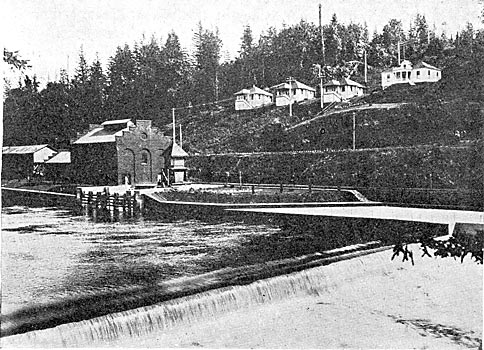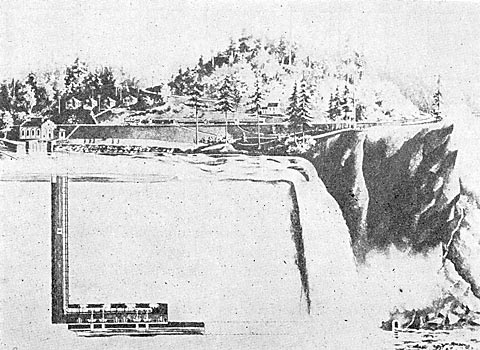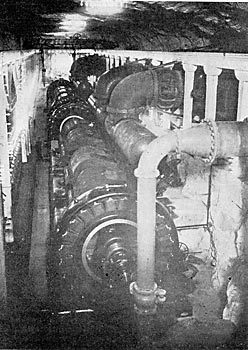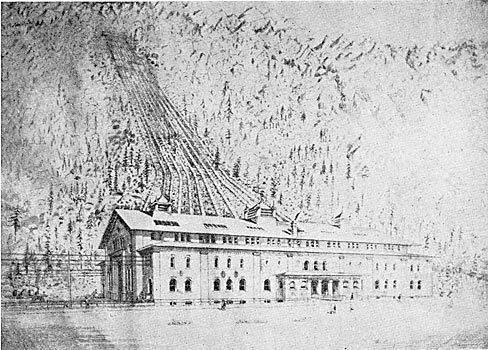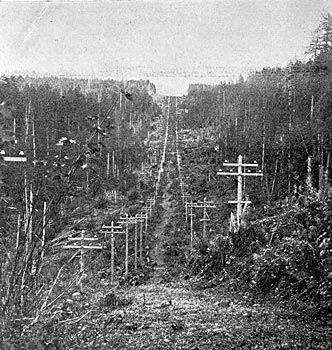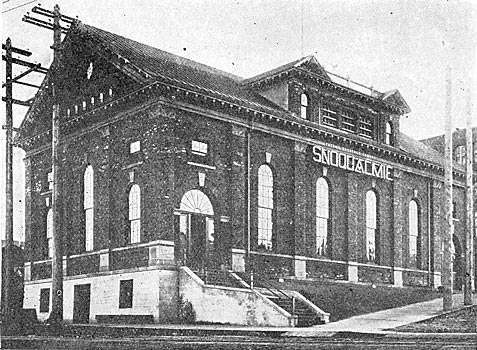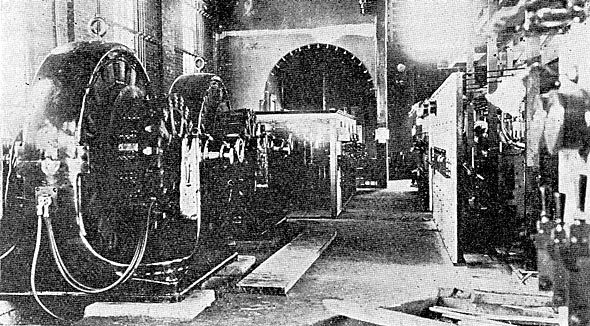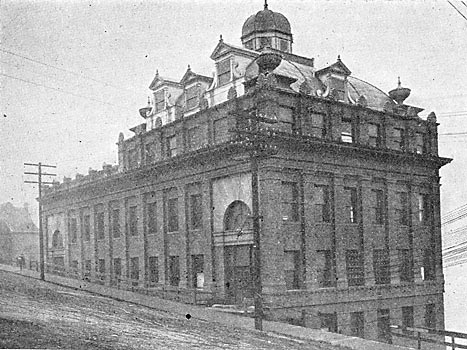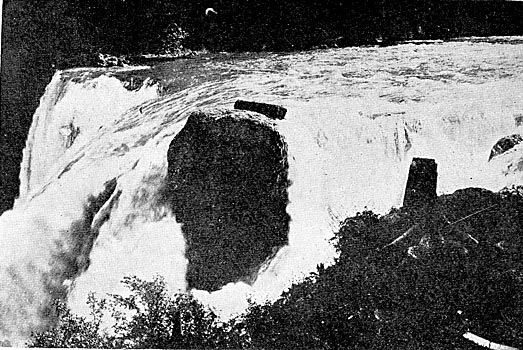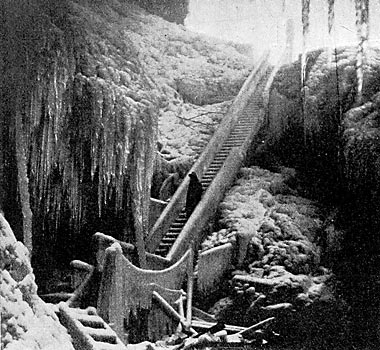[Trade Journal]
Publication: Electrical World and Engineer
New York, NY, United States
vol. 43, no. 19, p. 849-853, col. 1-2
The Snoqualmie Falls and White River Power Developments.
THE newly organized Snoqualmie Falls and White River Power Company, capitalized at $3,000,000, has acquired by purchase the properties of the noted Snoqualmie Falls Power Company, the Seattle Cataract Company and the Tacoma Cataract Company.
The Snoqualmie Falls Power Company was the pioneer long-distance transmission company in the Pacific Northwest, having a developed capacity of 11,000 hp, which has been in operation three years.
| |||
| Fig. 1. — General View at the Falls |
| |||
| Fig. 2. — Sectional Drawing of Head Waters |
The power generated at Snoqualmie Falls has been distributed through the agency of the Seattle Cataract Company and Tacoma Cataract Company. These two companies owned the franchises and the right to sell Snoqualmie power in the two cities, respectively. They owned the large and handsome sub-stations at these points and the distribution systems throughout the cities, and they marketed the product of the generating plants.
There has been an unprecedented demand for the power generated by the Snoqualmie Falls Power Company. Indeed, this company, both from the viewpoint of the electrical engineer and of the financier, has been an unqualified success. The company's gross earnings have been at the rate of $244,000 a year, and although its prices have been most moderate, its net earnings have been $120,000 per annum, which will be more than doubled after additional capacity is installed. Snoqualmie power is turning the wheels of the many factories and workshops of Seattle and Tacoma, and is running the trolley cars of Seattle, which carry 40,000,000 passengers annually. It supplies power to the Puget Sound Railway Company, commonly known as the "Interurban," which conveys more than a million people between Seattle and Tacoma yearly, and to the Seattle & Renton Railway Company, which carries 1,140,000 passengers annually.
To mention divers uses, this power grinds 9,000 bushels of wheat a day at the Centennial Mill and 2,200 bushels at the Hammond Mill, both of which plants are located in Seattle, treats 650 tons of ore a day at the Tacoma Smelter, and runs dentist's burrs in Seattle and Tacoma. It furnishes power for the Washington Iron Works Company, the largest industry of this sort in the Pacific Northwest, and for the Metropolitan Press, of Seattle, which prints most of the papers and periodicals published in this part of the country. It grinds spices and roasts coffee for the Crescent Manufacturing Company, and is the motive force of the Washington Shoe Company, which sends its products all through the Northwest and Alaska. Among other large users of power are the Seattle Electric Laundry, the flour and feed mill, operated by Lehman Bros. in Seattle, and the Tacoma Mill and Fransiola Mill in Tacoma, the hay presses and large feed mill of the Galbraith-Bacon Company and the smelting works and machinery of the large jewelry factory of Joseph Mayer & Bros., of Seattle.
| |||
| Fig. 3. — Underground Power Station |
Snoqualmie current furnishes light to the American Steel & Wire Company, for all of the Seattle tracks of the Northern Pacific Railway Company, and runs the motors of its machine shops; to many of the public buildings, stores, saloons and offices in Seattle and Tacoma; and it operates the motors of the numerous small industries of both cities.
Current is supplied to Renton, Kent, Puyallup, Sumner, Swansea, Issaquah and Auburn; and the two last-mentioned cities also obtain their street lighting from this source. Besides supplying Tacoma with most of the power and light for its factories, stores and residences, the Snoqualmie Company also has a contract for the entire city lighting, concerning which the Mayor of Tacoma recently wrote to Mr. Charles H. Baker, president of the Snoqualmie Falls Power Company. "If, throughout your five-year contract with the city, you continue to' supply this character of current, you will greatly benefit the city and retain the advanced position you now hold."
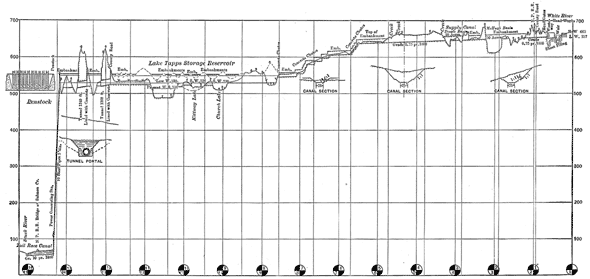 |
| Fig. 4. — General Profile of Snoqualmie Hydraulic Development |
Snoqualmie power is also being used by the Great Northern Railway Company in the construction of the important tunnel which it is carrying under the heart of Seattle in order to get its trains off of the main waterfront street of the city, and will light the tunnel both during the creative period and after it is in operation.
Mr. Charles H. Baker, who, in connection with his father, the late William T. Baker, promoted and built the Snoqualmie plant, has taken upon himself an entirely new promotion and development, in harnessing the water power of White River. For this purpose he has organized the White River Power Company, of which he is the chief engineer, and the active manager of its constructional operations. Mr. Baker's Snoqualmie plant is already overloaded owing to the rapid development of the Puget Sound country, and he, therefore, expects to find little difficulty in marketing the product of his White River Company, which already has applications for a considerable portion of its initial capacity. The White River power plant will supply current to the same sub-stations that the Snoqualmie plant does in addition to such new points of distribution as may be determined upon, the radius of profitable distribution being 250 miles in this territory already abundantly supplied with cheap coal and wood fuels. The White River Power Company was formerly owned by the Westinghouse Electric & Manufacturing Company, of Pittsburg.
It is now generally conceded that Snoqualmie River and White River afford the best commercial water powers tributary to the Puget Sound communities. While there are numerous streams in this section of the country—and any stream which has positive direction of flow may theoretically be a water power—yet practically it is unsafe to consider any stream as a commercial possibility unless its volume at minimum flow is ample and unless Nature has, figuratively speaking, done most of the work in the proposed power development, as in the case at both the Snoqualmie and the White River plants. It must not be lost sight of that Puget Sound already affords the cheapest fuels in the world for power in the shape of nearby coal and wood, and the first serious point to be considered by the hydraulic engineer, therefore, in order to protect investors is whether the proposed water power can successfully compete in cost. It is the careful consideration of this condition which bars nearly all the rivers and the streams in the Northwest from having significance as power possibilities. Streams which must be discarded for consideration in Puget Sound, would, if they could be shifted to other fields like California, Nevada and the Central States, where fuels are high, become important industrial factors and wealth producing agencies.
| |||
| Fig. 5. — White River Power House |
In the foothills of the Cascade Mountains, under the shadow of the snow-capped peak of Mt. Rainier, the White River Power Company is constructing a power plant which is destined to play a very important part in the development of that country, wonderfully rich in natural resources, lying between Portland, Ore., on the south, Vancouver, B. C., on the north, the Cascade Mountains on the east and the shores of Puget Sound on the west. Utilizing the water power of White River, a glacial stream having its source in Mt. Rainier, the company is constructing near Sumner, Wash., a power plant having a capacity of 50,000 electrical hp, of which 10,000 hp will be ready for distribution within one year's time. It will be unequaled in America in size, simplicity and first cost. The varied and multiple uses to which the Snoqualmie power is now being put give, however, only a hint of the demand that exists for electric current in the rapidly-growing section which will be fed by the White River Power Company.
The territory covered by the construction crews of the White River power development extends from Buckley (elevation 660 ft.) in the foothills of the Cascades to Sumner (elevation 65 ft.) lying in the level and fertile lower valley at the White River, a distance of ten miles. The headworks are located about three-quarters of a mile above the Northern Railway Company's trestle over the White River at Buckley. A concrete dam is being built across the river 9 ft. high and 500 ft. long. This dam will be provided with a sluice gate and automatic flash boards, which will eliminate injury to the dam from floating logs during the periods of high water. An intake 120 ft. wide, located on the south bank of the river, will lead into the first section of an open canal. This canal, which is 50 ft. wide and is 5 miles long from the intake to the storage basin at Lake Dorothy, follows an old channel of the White River; and owing to this provision by Nature of a ready-made canal site, it will not be necessary to build flumes at any point of the entire length of the construction work. By the use of four of the largest steam shovels obtainable and 1,500 men this part of the work will be pushed to a speedy conclusion.
| |||
| Fig. 6. — View of Transmission Line |
The company is most fortunate in being enabled by the natural conditions to develop an engineering plan entirely eliminating all fluming. All wooden flume features are a disastrous attribute of any power plant, particularly where there is not an extensive storage system as a guarantee of continuous service. The Bakersfield plant in California, which depended upon a two-mile flume, found the service so unreliable on account of the land slides and rock slides taking out the flume, that it penetrated a mountain with a two-mile tunnel through solid granite in order to abandon the flume construction. The longer the flume, the greater the liability to disorders.
The White River plant and the Snoqualmie plant have practically the same elevation of intake, viz.: 660 ft. above sea level. This is a most fortunate situation, for if they were any lower it would be at the expense of head, and any increase in elevation would proportionately reduce the area of watershed and particularly of the rain-fed portion of the watershed. It must be remembered that the Puget Sound rivers derive their winter flow from rains and springs, and their summer flow from snow and glaciers. The higher the intake elevation, therefore, the less the rain area controlled, and consequently the less the power capacity of the river for winter service. Under the load conditions in Seattle and Tacoma, the power requirements are thirty-five per cent. greater in winter than in summer, and the flow at the Snoqualmie and White River intakes responds to these conditions. Another favorable feature of the White River watershed is that the snow and glacier portion of it faces the north, and being thus sheltered from the hot summer sun, the melting is more gradual and later in the year, thus promoting a higher low water stage in the late summer. The Puyallup and Cowlitz glaciers lying upon the southern slope of the mountain disappear much earlier, so that these rivers suffer a more marked and protracted summer low water proportionately.
The first 1,300 ft. of the canal is being excavated along a side hill and will be lined with rubble stones. At the bottom this part of the canal is 25 ft. wide with slopes of 1/2 to 1, and the water will have a depth of 10 ft. From this point the canal, lined with concrete, crosses the county road, which will be bridged, and tunnels the embankment of the Northern Pacific Railway. Then the canal passes on to a series of alternately narrow and broad benches, which at some remote period formed the bed of the White River itself. These benches are open on the north, the river side, and sloping towards the south they are surrounded on three sides by a higher bench forming the flat part of the main land or plateau. The geological formation of the country, through which the canal passes, is cement and boulder gravel. On this foundation will be deposited by the natural action of the water the white sediment, from which the river gets its name. This sediment is a glacial silt, formed by the scraping of the glaciers of Mt. Rainier on the rock, and its characteristics are such that after it becomes caked it is practically as impervious to water as rubber. By the use of this substance the seepage of the canal will be reduced to a minimum at the outset, and it is expected that within two or three years it will be entirely eliminated.
The elevation of the intake was so established that it made it possible to lead the canal into four lakes—respectively, Hart Lake, of 8 acres; the McHenry Lake, of 68 acres; the McHugh, of acres, and the Campbell Lake, of 35 acres. In order to supplement the work of Nature it will only be necessary to build several low embankments, the material for which will be furnished by the earth taken from short cuts between the respective lakes. Like the canal these lakes will be rendered water-tight by the deposits of glacial silt. In them the white sediment will be made to settle in order that none of the silt shall be carried into the storage basin at Lake Dorothy.
| |||
| Fig. 7. — Tacoma Sub-Station |
| |||
| Fig. 8. — Interior of Tacoma Sub-Station |
After leaving the settling basins the water is carried from the intermediate bench through a cut to the high bench, and from this point traverses the main flat country in a westerly direction for 3 1/2 miles until it reaches the Lake Dorothy storage basin. This section of the canal is 100 ft. wide on the surface and 50 ft. wide at the bottom, with slopes of 2 to 1; the depth of water will be 11 ft. To utilize the settling basins, previously mentioned, the location of the intake was so determined that the canal emerges at an elevation of 100 ft. higher than the storage basin. This difference in level will be overcome by guiding the water down over successive chutes to the storage basin. Had the intake been placed so as to avoid the use of these chutes, the canal would necessarily have had to be built along the steep side hills of the White River canyon, thereby entailing the construction of several miles of flumes, a structure that would have been enormously expensive in first cost and maintenance and neither permanent nor reliable.
The White River, while glacial in its origin, is also largely fed by rain and melting snow. During the winter the flow of water is the largest, for it is rarely cold in this part of the country for any length of time, and the warm Chinook winds cause the snow falling on Mt. Rainier and the Cascades to melt rapidly. The floods vary with the precipitation of snow and rain, but the highest flood recorded is 60,000 c.f.s. Only in one month of the year is the flow less than 2,000 c.f.s., the quantity required for the operations of the company on a basis of 120,000 theoretical hp. In October the flow drops as low as 600 c.f.s., and all of this will be taken with the exception of 30 c.f.s., which the federal law requires shall be left in the river to keep the fish alive and for domestic use. During the other months of the year the control gates of the intake will admit only the 2,000 c.f.s. needed to run the company's water wheels.
Through the magnitude of the Lake Dorothy storage basins, however, the company will always have in reserve a vast volume of water for the use of its generating station, which will be constructed in the White River valley, near Sumner below the storage basins. This basin is the most important feature of the whole plan of the White River Power Company, as it is the largest storage basin controlled by any power company in the United States, being only exceeded in capacity by the Great Lakes, which feed Niagara Falls. Another great advantage that this basin has is that it is situated directly over the station in which the water will be used for generating power.
Its location, unlike that of some storage basin remote from the power plant, removes the supply of water from all uncertainties. By the time that the water has reached the storage basin, all dangers from logs and log jams, from breaks in the dam or in the canal or from other causes, are entirely obviated. The Lake Dorothy basin is, therefore, the principal factor in the undertaking of the company.
| |||
| Fig. 9. — Seattle Sub-Station and Office Building |
Until the White River Power Company secured the ownership of the territory surrounding the largest lake, which will be used for a storage basin, it was known as Lake Tapps, the present area of which is 620 acres. In its close proximity are three other lakes, respectively Kirtley Lake, of 80 acres; Church Lake, of 40 acres, and Crawford Lake, of 20 acres. Like that of the canal right of way and the settling basins, the natural contour of the country around the storage basin is such that it might appear as if Nature intended these lakes for the purpose that the company now proposes to utilize them. The present elevation of Lake Tapps is 515 ft. above the sea level; Church Lake, 530 ft., and that of Kirtley Lake is 526 ft.; but work is now progressing on a series of embankments, making it possible to raise the level of Lake Tapps 35 ft., thus securing a water area of 4,000 acres, which is about seven times larger than the present area. The storage capacity of the Lake Dorothy basin, roughly computed, will be 5,227,200,000 cu. ft., as the average draw-down of water in the basin will be 30 ft. and this means 50,000 hp for two months.
The land controlled by the company, extending from Buckley to Sumner, comprises an area of 6,500 acres. Of this total area 4,000 acres are used for the storage basin, 120 acres are required for the canal and the three settling basins; the headworks cover an area of to acres; and the generating station and other buildings in connection with the power plant require 10 acres. A total of 4,140 acres will, therefore, be used in the actual operations of the power company. The balance, 2,360 acres, is controlled by the Lake Dorothy Improvement Company, a corporation organized under the laws of the State of Washington, and will be developed as a pleasure resort by that company.
The power company has a valuable asset in the vast quantity of timber standing on the lands that it has acquired. It has been estimated that the company owns 200,000,000 ft. of timber, 50,000,000 ft. of which is classed among the best cedar standing in the State, and there are over 100,000,000 ft. of fir in prime condition. The canal right of way and basins have been so commonly submerged by the high waters of the White River that forest fires have done very little damage to the timber. Therefore, taken as a whole it is in a better state of preservation than that in most of the sections of the State. To utilize this "by-product," the power company will erect a saw-mill in the White River valley, near the Northern Pacific Rail way, which will have a daily capacity of 100,000 ft. It is expected that this saw-mill will be ready for use about the time that the power plant is in actual operation, which will be in one year's time. The output of the saw-mill will be disposed of in the open market, and will largely enhance the company's revenues.
As a result of the submersion of the ranches contiguous to the storage basin, which will be done as soon as the embankments surrounding, the lakes are completed, the whole contour of the country will be very much changed. What are now little hills will then be islands, and the valleys between them will be covered with water. These islands and the shores of the lake, an area of 2,360 acres, are controlled by the Lake Dorothy Improvement Company for improvement purposes, which has before it an unparalleled opportunity of building up one of the famous summer resorts of the country. Nature has surrounded the field of its operations with scenery of marvelous beauty. The country, lying as it does in the foot hills of the mountains, is varied in character, commanding a wide view of the Cascade Range and of the fertile White River valley as well. The waters of Lake Dorothy will be studded with twenty-two islands of various sizes, but all of them large enough to be susceptible of improvement for summer residences and pleasure resorts. Lake Tapps now has, for a small lake, a widely diversified aspect, owing to the fact that it has many coves and several long arms, which afford abundant opportunity for exploration by the adventurous, whether in a launch or in a canoe. This feature of the lake will, of course, be greatly intensified when the waters of the storage basins are raised 35 ft., bringing about a seven-fold increase in its area. Owing to the fact that Lake Dorothy is only ten miles from Tacoma and twenty-four miles from Seattle, the principal cities of Puget Sound, it will easily be possible to make it a great summer resort. It is estimated that 50,000 people have visited the falls since the company secured the property which it controls. At Lake Dorothy it will be particularly easy to handle large crowds, as the main line of the Puget Sound Electric Railway now runs within two miles of the company's camp, making it necessary to construct only a short spur to reach the lake.
Besides erecting cottages, pavilions and the like, the company will construct a bungalow 68 by 52 ft. on one of the islands, which will be ready for occupancy next summer.
The generating station near Sumner, in the White River valley, will be housed in a two-story building, of which the main dimensions are 219 by 116 ft. This structure will be built of brick, stone and iron, so that it will be practically indestructible. In this building will be located, on the first floor, the office, a carpenter shop, a machine shop and a blacksmith shop. Railroad tracks run through the center of the station to facilitate the handling of the machinery. These will have a spur connection with the main line of the Northern Pacific Railway Company. A traveling crane of 50-tons capacity will be installed which can be operated with ease in any part of the building.
Leading from the Lake Dorothy storage basin provision will be made for ten 48-in. pipes, which will carry water to ten water wheels operating ten generators of 5,000-hp capacity each. All of the electrical equipment of the plant will be of the Westinghouse type. The water flowing through the penstock will have a net fall of 485 ft. Each bank of three transformers will be housed in a fire-proof compartment. On the second floor of the station will be located the high-tension and operating galleries and the switchboard.
| |||
| Fig. 10. — Brink of the Falls |
The generators and transformers are connected for operating each set of transformers on their own generators, and also for operating a set of transformers on any generator for emergency cases. Under ordinary operating conditions the generators will be in parallel. Double-break oil switches having a vertical lift of the plunger will be used and will be operated by electric pneumatic control. Integrating wattmeters will be placed on each machine to record the total output. Lightning arresters will be connected to the line through switches controlled by electro-pneumatic cylinders from the switchboard, ammeters being placed in the lightning arrester leads to show when current is flowing through them. In the event of current passing through the lightning arresters, they will be opened by the oil switch and immediately closed, which will usually have the effect of discontinuing any possible arcing and will avoid frequent shut-downs, which occur by the short-circuiting of lightning arresters. A very sensitive center zero reading voltmeter with adjustable resistance in its circuit will be used for watching and holding constant the voltage of the plant.
The face of the switchboard will carry upon it between the instruments a diagram of the connections, the voltmeter being used to represent the generator. Breaks are made in the red line diagram which is thus painted upon the instrument board, and these are the appearance of a continuous line through the otherwise open break in the line or bus-bars.
| |||
| Fig. 11. — Ice Formation at Mouth of Tail Race |
For the use of the officers and employees of the company a two-4 story building, known as the men's barracks, will be erected near the power house, the main dimensions of which will be 68 ft. by 45 ft. The first floor of the building will provide for a library, a kitchen, a dark room and a chemical room. On the second floor there will be rooms for the president, the superintendent and the housekeeper and seven bed chambers, besides the usual conveniences in way of baths and toilets. There will also be a large attic, which can be utilized for sleeping purposes in cases of emergency.
The White River generating plant will deliver its power into the same transmission system, which is supplied by the Snoqualmie Falls generating plant. This is a most elaborate and substantially constructed system, there being two independent pole lines and two circuits from each generating station, to the two terminals. The transmission is seven-strand aluminum cables, supported on "Imperial" porcelain insulators and the spacing of the wires in each circuit is 9 ft. in the triangle between centers. The aluminum conductors have given most marked satisfaction and the reliability of the service has proved itself unexcelled by any other plant in the country. The transmission is soon to be extended south in the direction of Portland, and north in the direction of Bellingham.
Mr. Baker and his associates have something like two million and a half dollars invested in the various enterprises which he has exploited, and the completion of the plans as they will progress from time to time with the development of the country upon the general scope laid down by Mr. Baker will aggregate an investment exceeding $8,000,000.

